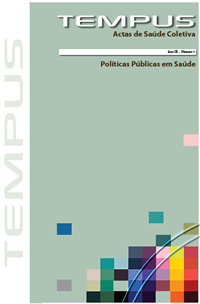Abstract
the survey had the objective to become aware of the opinion of the delegates from the 14th National Health Conference during the period of the 1st to the 4th of December, 2011. About the technology assessment criteria for the public health system in Brazil (SUS). A self-questionnaire survey was applied to all visitors at a Ministry of Health booth in the event. About 11.5% (502/4370) participants were covered by the survey. Of these, 43.6% represented citizens/patients; 33.6 % health professionals, 13.1% policymakers; 3.8% service providers and 5.9% others. The majority of them have participated in SUS social control for more than five years. Eleven of the pre-defined criteria for technology assessment on the questionnaire were put in a hierarchical order in the following manner: improved quality of life and patient survival (60%); evidence on the anticipated effects in prevention, diagnostics, treatment or rehabilitation (49%); evidence regarding safety for patient/user/consumer (46%); impact on the population’s health (43%); relationship between benefits/effects of the technology and the costs (40%). The criteria “costs for the health system” and “costs for patients” were in second to last and last place, respectively. The perspectives of patients/citizens and health professionals should be stimulated in order to support the application of the Law 12,401/2011, which establishes criteria for Incorporation of Health Technologies.References
Goodman CS. HTA 101: introduction to health technology assessment [Training Material and Manuals]: U.S. National Library of Medicine; 2009. Available from: http://www.nlm.nih.
gov/nichsr/hta101/ta101_c1.html.
Silva, H. P.; Petramale, C. A.; Elias, F. T. S. Avanços e desafios da Política Nacional de Gestão de Tecnologias em Saúde. Revista de Saúde Pública (Impresso), 2012, 46: 83-90.. Disponível em: http://www.scielo.br/scielo.php?script=sci_
arttext&pid=S0034-89102012000700012 Acesso em 23.abr.2015
Donabedian A. The quality of care. How can it be assessed? JAMA. 1988, 260(12):1743-
Bastian H, Scheibler F, Knelangen M, Zschorlich B, Nasser M, Waltering A. Choosing health technology assessment and systematic review topics: the development of priority-setting
criteria for patients’ and consumers’ interests. Int J Technol Assess Health Care. 2011; 27(4):348-56.
Health Equality Europe. Understanding health technology assessment. 2013. Disponível em: http://www.htai.org/fileadmin/HTAi_Files/ISG/PatientInvolvement/EffectiveInvolvement/
HEEGuideToHTAforPatientsEnglish.pdf. Acesso em 24.abr.2015
Devidas M; STAFINSKI, T. Role of patient and public participation in health technology assessment and coverage decisions. Expert Review of Pharmacoeconomics & Outcomes Research.2011, 11 (1): 75-89.
Health Technology Assessment International. Patient and citizen involvment. 2013. Disponível em: http://www.htai.org/index.php?id=545 Acesso em 24.abr.2015.
Littlejohns P, Yeung K, Clark S, Weale A. A proposal for a new social values research program and policy network. J Health Organ Manag. 2012; 26(3):407-21.
Banta D, Almeida RT. The development of health technology assessment in Brazil. Int J Technol Assess Health Care. 2009;25 (Suppl 1):255-9.
Health Technology Assessment: institutionalization of actions in the Brazilian Ministry of Health. Rev Saúde Pública. 2006;40(4):743-7.
Brasil. Lei nº 8.142, de 28 de dezembro de 1990. Dispõe sobre a participação da comunidade na gestão do Sistema Único de Saúde (SUS} e sobre as transferências intergovernamentais de recursos financeiros na área da saúde e dá outras providências. Diário
Oficial da União 31 dez 1990.
Brasil. Ministério da Saúde. Conselho Nacional de Saúde. Relatório final da 14ª Conferência Nacional de Saúde: todos usam o SUS: SUS na seguridade social: Política pública, patrimônio do povo brasileiro. Brasília: Ministério da Saúde; 2012.
Ryan M, Scott DA, Reeves C, Bate A, Van Teijlingen ER, Russell EM, et al. Eliciting public preferences for healthcare: a systematic review of techniques. Health Technol Assess. 2001;5(5):1-186.
Varela-Lema L, Merino GA, García ML, Martínez MV, Triana EG, Mota TC. [Requirements for and expectations of health technology assessment in Galicia (Spain). A qualitative study from the perspective of decision-makers and clinicians]. Gac Sanit. 2011;25
(6):454-60.
Husereau D, Boucher M, Noorani H. Priority setting for health technology assessment at CADTH. Int J Technol Assess Health Care. 2010; 26(3):341-7.
Chalkidou K, Whicher D, Kary W, Tunis S. Comparative effectiveness research priorities: identifying critical gaps in evidence for clinical and health policy decision making. Int J Technol
Assess Health Care. 2009 ; 25(3):241-8.
Clark S, Weale A. Social values in health priority setting: a conceptual framework. J Health Organ Manag. 2012; 26(3):293-316.
Ahn J, Kim G, Suh HS, Lee SM. Social values and healthcare priority setting in Korea. J Health Organ Manag. 2012; 26(3):343-50.
A Tempus garante critérios rigorosos, por meio de avaliação sistemática. Os autores se responsabilizam pela veracidade e ineditismo do trabalho cabendo a eles a cessão de direitos de publicação à revista. A confiabilidade dos conteúdos e a marca própria de apresentação tem como objetivo uma comunicação personalizada, adaptada aos padrões da revista, na medida em que adota critérios de excelência exigidos por seus usuários e especialistas, considerando os rigores da comunicação científica. Os autores devem especificar sua contribuição individual na concepção, delineamento, execução do trabalho, análise ou interpretação dos dados, redação e aprovação final do manuscrito. Incluir Fontes de financiamento e de apoio logístico das pesquisas. Ao final da submissão do artigo, os autores devem enviar uma declaração de cessão de direitos de publicação à Revista TEMPUS , assinada e no formato PDF (Portable Document Format ): Modelo da declaração de cessão de direitos.
